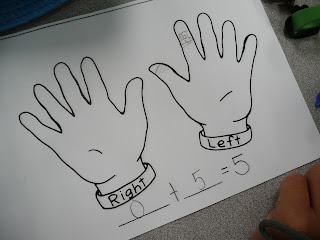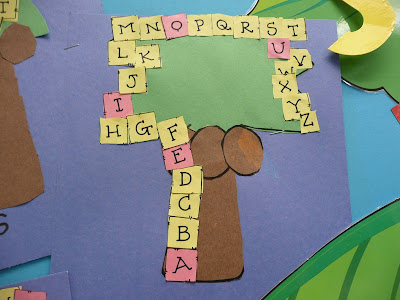Our class did a little 'action research' this week. The students ate their snacks outside at morning recess time. On Friday I asked them to choose to respond to the question "Do you like your snack at recess or after recess?" The results were so very close, with one more student preferring after recess than during recess. We are going to compromise. During the months when there is no snow on the ground, the students will be eating their snacks outside. During the months when there is snow on the ground, snacks will be eaten inside, which should avoid frozen fingers!
The students got a chance to work in small groups on some math activities. The tubs each had a different concept to explore including patterns,
creating equations,
searching for data, creating tally marks and using this information to create a graph,
recognizing the sequence of numbers.
rolling a die and reading 'teen numbers' with a partner,
and reading the words: one, two, three, four and five.
The students worked in small groups of four, so co-operation was also key!
This week the students' learning hinged on the stories where a blue cat named Pete is the main character. Pete has a good attitude and shares this attitude in the stories that we read. On Friday we looked at this story:
It became the jumping off place for exploring 'Growth Mindset'
Carol Dweck, researcher, explains it this way:
“In a growth mindset, people believe that their most basic abilities can be developed through dedication and hard work—brains and talent are just the starting point. This view creates a love of learning and a resilience that is essential for great accomplishment. Virtually, all great people have these qualities. Teaching a growth mindset creates motivation and productivity in the world of business, education, and sports. It enhances relationships.”
An example of a growth mindset would be:
Instead of ' I can't do this!' THINK: 'I'm going to train my brain.'
OR Instead of 'I give up!' THINK: I'll use a different strategy.'
We used the story "Pete the Cat and His Four Groovy Buttons" to create equations.
Work in this area is needed by some. In this first example, no equation was written.
The information the kiddo created in the story does not match the equation.
The solution in the equation is not correct in this example.
Check your child's backpack for the letter on our latest challenge, learning to tie our own shoes. Hope the kiddos were practising this weekend. Pete has sent us 'brag tags' for those who can demonstrate this important life skill.
Another painting project! The students followed the verbal directions and the projected steps in this directed drawing activity. They then used their Sharpie pen (by the way...not all students had one???) to outline their pencil drawings and we again practised the skill of water colour painting, filling the brush with colour, using long strokes in one direction and not scrubbing back and forth like you would with a crayon.
Progress is being made! Hooray!






















































